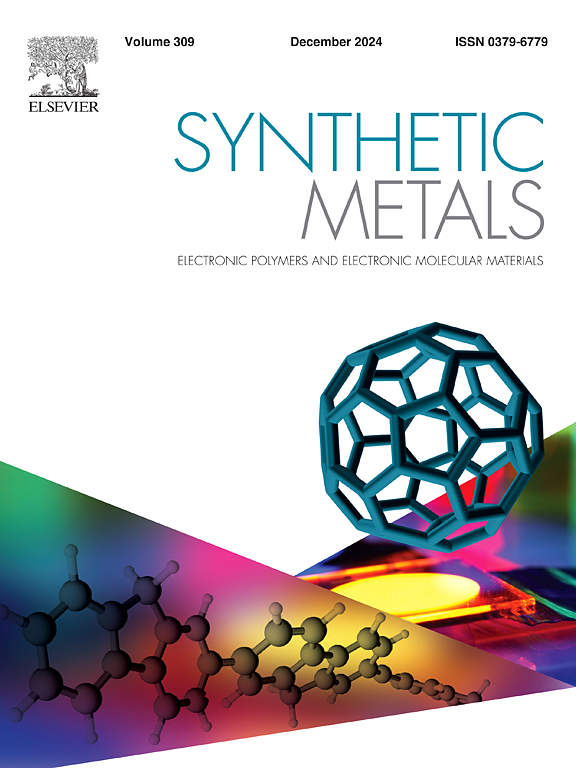柔性n型碳纳米管薄膜/聚(苯并咪唑苯并菲罗啉):聚乙烯亚胺热电复合材料
IF 4.6
3区 材料科学
Q2 MATERIALS SCIENCE, MULTIDISCIPLINARY
引用次数: 0
摘要
采用简单浸渍法制备了宏观碳纳米管膜/聚苯并咪唑苯并菲罗啉:聚乙烯亚胺(CNTF/BBL:PEI)复合材料。在360 K下,CNTF/BBL:PEI复合材料的功率因数为525.8 μWm−1K−2,相应的电导率为1121.8 S/cm,塞贝克系数为−68.6 μV/K。用聚苯乙烯-b-聚异戊二烯-b-聚苯乙烯(SIS)包封后,相应的CNTF/BBL:PEI-SIS复合材料表现出良好的环境稳定性,在空气中暴露15天后,功率因数下降了5 %。此外,CNTF/BBL:PEI-SIS复合材料表现出良好的柔韧性,即使在2000次弯曲循环后仍保持其原始功率因数的87.0 %。与原始CNTF相比,CNTF/BBL:PEI-SIS复合材料的力学性能得到了增强,断裂伸长率和拉伸韧性分别达到64.5 %和45.1 MJ/m3。在温度差为25.4 K时,组装的四支热电装置的输出功率为809.1 nW。这些结果表明,CNTF/BBL:PEI-SIS复合材料在可穿戴电子产品中具有应用潜力。本文章由计算机程序翻译,如有差异,请以英文原文为准。
Flexible n-type carbon nanotube film/poly(benzimidazobenzophenanthroline):polyethyleneimine thermoelectric composites
A macroscopic carbon nanotube film/poly(benzimidazobenzophenanthroline):polyethyleneimine (CNTF/BBL:PEI) composite was prepared via a simple impregnation process. The CNTF/BBL:PEI composite exhibited a power factor of 525.8 μWm−1K−2 at 360 K, with corresponding electrical conductivity of 1121.8 S/cm and Seebeck coefficient of −68.6 μV/K. After being encapsulated with polystyrene-b-polyisoprene-b-polystyrene (SIS), the corresponding CNTF/BBL:PEI-SIS composite demonstrated favorable environmental stability, with the power factor decreasing within 5 % after 15-day air exposure. Additionally, the CNTF/BBL:PEI-SIS composite exhibited good flexibility, maintaining 87.0 % of its original power factor even after 2000 bending cycles. Compared to the pristine CNTF, the CNTF/BBL:PEI-SIS composite displayed enhanced mechanical properties, with elongation at break and tensile toughness reaching 64.5 % and 45.1 MJ/m3, respectively. An output power of 809.1 nW was achieved for the assembled 4-leg thermoelectric device at a temperature difference of 25.4 K. These results show that the CNTF/BBL:PEI-SIS composite has potential for applications in wearable electronics.
求助全文
通过发布文献求助,成功后即可免费获取论文全文。
去求助
来源期刊

Synthetic Metals
工程技术-材料科学:综合
CiteScore
8.30
自引率
4.50%
发文量
189
审稿时长
33 days
期刊介绍:
This journal is an international medium for the rapid publication of original research papers, short communications and subject reviews dealing with research on and applications of electronic polymers and electronic molecular materials including novel carbon architectures. These functional materials have the properties of metals, semiconductors or magnets and are distinguishable from elemental and alloy/binary metals, semiconductors and magnets.
 求助内容:
求助内容: 应助结果提醒方式:
应助结果提醒方式:


